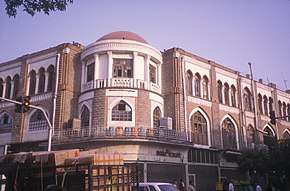Laleh-Zar Street
Laleh-Zar street (Persian: خیابان لالهزار) is one of the oldest streets of Tehran, Iran. This street is bordered to the south by Imam Khomeini square (former Toopkhaneh), and to the north by Enqelab Street (former Shah Reza Street).[1]
| |
|---|---|
| خیابان لالهزار | |
 | |
| Route information | |
| Existed | circa. 1873–present |
| Major junctions | |
| North end | Enqelab Street |
| South end | Toopkhaneh square |
| Highway system | |
| Highways in Iran Freeways | |
At the end of the Qajar era and beginning of the Pahlavi era it was a symbol of modernism and art of Iran and was called as "Tehran's Champs-Elysées".[2] Many theaters, restaurants, businesses, cabarets, dish-sellers, dressmakers, cinemas, and famous shops of Iran were located in this street.[3][1]
Laleh-Zar district was Once the street in which all the cinema of Tehran were placed. The first movie in the history of Iran was shown in the Laleh cinema. This cinema itself was first inaugurated in 1945 and Prior to that this region was once the place of Mosafa garden, a Royal garden for the families and a place for the diplomats.
This street is also the birthplace of the first passage of Iran based on a western architecture.
Due to the interest of Qajars and the western layout of this street also many other advancements first started right here. For instance, The first telegram wire of Tehran was initiated in this sub region and since then many things have changed.[1]
History
After Nassereddin Shah's first visit to the Europe (which was in 1873), he ordered that a street like the Champs-Elysées be constructed in Tehran.[3]
Later, at the time of the Pahlavis, singers of Iranian popular music like Mahvash, Afat, Ghasem Jebeli, Tajik, Roohparvar, Ali Nazari, Aghasi, Soosan, and Iraj Habibi all sang in cabarets on this street.[2][4]
Jafar Shahri, in the book "Old Tehran", notes that[5][6]
Eshghi and Aref were performing their best works in Laleh-Zar's Grand Hotel amphitheater, and waggish ladies with European styles along with tall boys, were going there from the beginning of night, and most fashionable men and stylish women could be found in that street.
At one time, there were 15 cinemas and multiple theaters active there, however today only ten cinemas are active in this street, most of which have lost their popularity.[7][8]
References
- "laleh zar dsitrict in tehran". rent iran apartment blog. Retrieved 2019-03-24.
- "لاله زار، از نوگرایی تا گورستان سینماهای ایران". تهران ۲۴ (in Persian). 2018-08-27. Retrieved 2019-03-24.
- "کهنترین خیابان طهران کجاست؟ +عکس". اقتصاد آنلاین (in Persian). Retrieved 2019-03-24.
- "موسيقى لاله زاری یا مردمی؛ «آغاسی و سوسن محبوبیت بیشتری داشتند»". رادیو فردا (in Persian). Retrieved 2019-03-24.
- "تعطيل تئاتر پارس؛ پايان لاله زار". www.bbc.com (in Persian). Retrieved 2019-03-24.
- شهریباف، جعفر. طهران قدیم. تهران: معین، ۱۳۷۶. صفحه ۲۷۸. شابک ۹۶۴-۵۶۴۳-۶۶-X.
- "«یادی از قدیمای تهران» فیلمی نادر، رنگی و خاطرهانگیز از خیابان لالهزار در سال ۱۳۳۵+ تاریخچه". ایران کارگر (in Persian). 2018-07-13. Retrieved 2019-03-24.
- "تهران محله به محله - لالهزار". ایسنا (in Persian). 2018-09-12. Retrieved 2019-03-24.